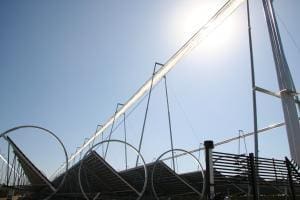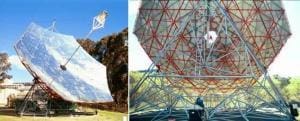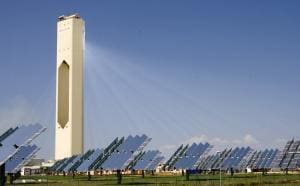When most people think of solar power, they imagine solar photovoltaics, the technology whereby sunlight is turned directly into (dc) electricity via the p-n junction of a semiconductor material, such as silicon. In fact, in Australia, most solar installations are this type–the solar panels used in most residential solar installs are either poly-crystalline silicon, mono-crystalline silicon, or amorphous thin film silicon. The other main method for harnessing the sun’s energy, however, is concentrated solar power (CSP), which focuses the suns beams to generate heat. What are the different types of CSP?
Whereas photovoltaics can be efficient and coste-effective even for small-scale residential solar projects, CSP technology is ordinarily deployed on the medium- to large-scale, and is not particularly efficient for small applications. There are four major types of concentrated solar technology that can be found in commercial solar power plants throughout the world: parabolic trough, Fresnel reflectors, dish/engine systems, and solar power towers. All of these technologies utilise the power of the sun to heat liquids (solar-thermal) and spin turbines, creating energy in much the same way as conventional power plants do. The types of CSP are describe briefly below.
Parabolic trough
Parabolic trough technology consists of a series of linear reflectors designed to focus sunlight on a bar or tube that runs the length of each trough. The tube is filled with a liquid, sometimes a molten salt, that after heating is pumped through a network of pipes and used to boil water and spin a turbine. This technology is one of the most widely used CSP technology. One example of solar trough technology in use is the Nevada Solar One plant in Boulder City, Nevada; 64MW over 400 acres.
Parabolic Troughs at the Nevada Solar One project–Boulder City, Nevada (Photo from www.acciona-na.com)
Compact Linear Fresnel reflectors (CLFR)
CLFR technology is comparable to parabolic trough technology, except that there are multiple flat reflectors beneath a number of absorber tubes. The reflectors concentrate the sun’s energy on the tubes, which again heat a liquid inside which is used to boil water and spin turbines. CLFR technology is not as efficient as solar troughs, but can be more cost effective as the reflectors do not need to be curved. CLFR technology is to be deployed to supplement power produced by a coal-fired plant in Kogan Creek, Queensland.
Ausra’s Kimberlina CLFR plant in Bakersfield, California (image from www.ausra.com)
Dish/engine systems
Dish/engine systems work on a principle essentially the same as that of the so-called Solar Death Ray designed by an Indianan teenager in his back yard: a mirror or mirrors arranged on a rounded dish that reflects and concentrates the light onto one point. They are kind of like stand-alone parabolic reflectors, and can be efficient and scalable when Sterling engines or other heat collection devices are situated in the where the light concentrates. One example of a dish system in use is ANU’s cleverly named “Big Dish” (pictured below).
Australian National University “Big Dish” (image from solar-thermal.anu.edu.au/)
Solar power towers (solar receivers)
Many envision Solar Towers when they think of Concentrated Solar Power. Solar Tower projects can be huge and dramatic in appearance. A large tower is placed in the middle of a large swath of land, and reflecting concentrators are aimed at one point in the tower, where a liquid (often molten salts) is heated, pumped, and used to spine turbines and produce electricity. Depending on the type of medium used, electricity produced in this type of plant can actually be stored in the liquid during periods of inclement weather or during the evening when the sun is not shining. The Planta Solar 10 in Sevilla (Sanlúcar la Mayor), Spain is a shining example of this technology, and the first purely-commercial ‘receiver’ type plant in operation in the world.
PS10 Planta Solar in Seville, Spain (source: http://www.flickr.com/photos/74424373@N00/1448540190/)
© 2011 Solar Choice Pty Ltd
- Solar Power Wagga Wagga, NSW – Compare outputs, returns and installers - 13 March, 2025
- Monocrystalline vs Polycrystalline Solar Panels: Busting Myths - 11 November, 2024
- Solar Hot Water System: Everything You Need to Know - 27 February, 2024



